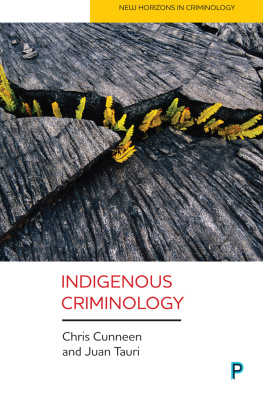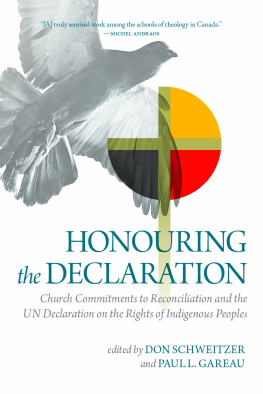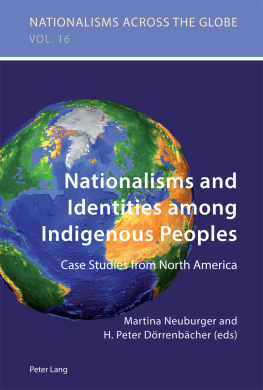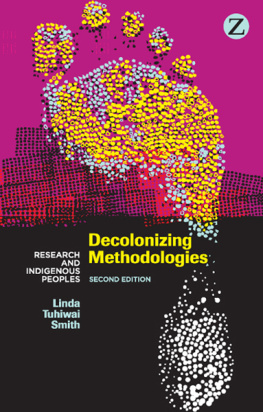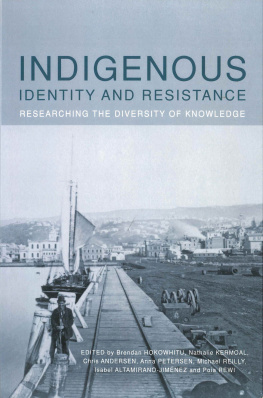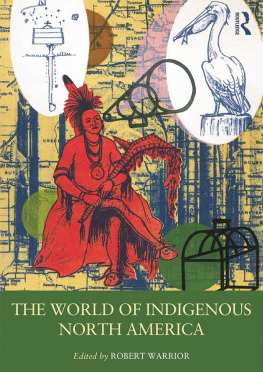ACKNOWLEDGEMENTS
This volume would have not been possible without the help and support of contributors, students, colleagues, and senior university leaders.
First and foremost, we express our heartfelt gratitude to Indigenous colleagues for their time and interest in discussing Indianthusiasm with us and contributing the bulk of this volume.
We are grateful to the University of Calgarys Killam Grants Committee, which awarded Hartmut Lutz the Killam Visiting Scholar Fellowship that brought him to Calgary in 2012 and allowed us to begin this project. The University of Calgarys Faculty of Arts provided generous research funds to support the project, and additional funding was provided by the Gesellschaft fr Kanada-Studien (GKS), the German Association for Canadian Studies.
The interviews we recorded required transcription. Many graduate students, both Indigenous and non-Indigenous, from the University of Calgary worked on these transcriptions. Vicki Bouvier, David Gallant, Paulina Maczuga, and Bernadette Raedler provided the very first drafts of the central part of this volume. A postdoctoral fellow at the University of Calgary, Christopher Geissler, provided initial feedback on early drafts of the introduction.
Dianne Hildebrand, experienced editor, strategic communications specialist, and designer of Indigenous teaching resources, supported the editing of the transcribed interviews and the overall format of the volume. Ruth Lutz-Preiskorn is to be credited with generating the index to the volume, increasing its usability for researchers and students.
We want to thank Siobhan McMenemy from Wilfrid Laurier University Press and copy editor Matthew Kudelka for their advice and guidance on bringing this anthology to completion. We are also very grateful for the constructive criticism the anonymous reviewers of our manuscript provided.
We dedicate this book to the memory of our friends Jo-Ann Episkenew (19522016) and Ahmoo Angeconeb (19552017), who sadly passed away before seeing this anthology in print. We remain immensely grateful for their generosity, their good humour, and the enlightening thoughts they so generously shared with us.
AFTERWORD
In their teachings, Indigenous knowledge holders and traditional educators tend to refrain from abstract didacticisms and generalizing interpretations, but rather rely on the power of stories to unfold, and respectfully give the recipients the space to arrive at their own conclusions. Our volume follows this approach and encourages readers to develop their own perspective from the accounts of those interviewed. We conclude this book by doing the same ourselves, and, again following Indigenous protocol, locate ourselves in relation to what we have heard from those we asked, and share what we have learned in the process.
Renae Watchman
I was born in Ogden, Utah, in 1974 to teen parents who were on the infamous Indian Placement Program established by the LDS Church. My maternal grandma, shimsn, or grams, once told me she did not even know I existed until I was six months old, when my mother returned home to the rez, to Shiprock, New Mexico, to finish her senior year of high school. My aunts and uncles have shared stories with me about my upbringing, but my clearest memories are those with my grams. My parents struggled as most teen parents on the rez do, so I was fortunate to have some stability in my grams as a young girl. As I got older, I inherited big sister duties as a mother figure to my siblings. My experience was typical perhaps of tumultuous motherdaughter relationships, yet extraordinary in that there was physical and emotional violence that I normalized. During eighth grade, I left home due to a heated physical exchange, and chose to live with my uncle Bobby Watchman for an entire year. The following year, I transferred to Navajo Academy, and I moved back home, but I did not stay. The violence continued, and one incident resulted in my having two black eyes, which I tried to hide behind sunglasses. I was a strong student who hid my home life, but this particular morning I could not hide the abuse any longer.
Instead of calling the local authorities as mandated, my then-principal as well as the guidance counsellor investigated my records to discover that I was an A student. They feared that being placed in foster care would have a negative impact on my educational opportunities. They probed me to find out if I had any options: did I have a safe place to stay during the weekends, if I stayed in the dorms during the school week? I told them I could stay at my uncles or at another caregivers house on weekends. They probed further, Thats fine, but what about the summer? And what about next year? They were thinking ahead about my future, but I was frustrated with the questions and I shot back, I dont know! Why dont you just send me to another country for the year? I saw a light bulb go off above their heads. Navajo Academy (revamped as Navajo Preparatory School in 1991) had a brief history with hosting foreign exchange students from northern European countries, but it was, up until then, a one-way exchange. One of Navajo Academys chemistry teachers was also a local representative of the American Scandinavian Student Exchange (ASSE) program. With the guidance of these three principal, counsellor, and chemistry teacher I was aided in the arduous process of applying to become a foreign exchange student. The principal asked me where I wanted to go for a year, but, as an unseasoned traveller, the answer to that question was abstruse and unreal. My principal (a non-Din) suggested Germany, and for all I knew, he could have just as easily spun a globe and randomly used his index finger to stop it at a destination. I had no knowledge of German language or culture and, coming from the Navajo Nation, I had no reason to continue my own learning with all things German beyond this exchange year, so I was willing to leave home for another world. In total ASSE selected forty students from North America for the program. Of these forty students, I was one of two selected to receive a 95 percent stipend. The remaining 5 percent was covered by the Navajo Nation for my flight from Farmington, New Mexico, to JFK in New York.
My first direct experiences with Germans and Germany, then, were during my junior year of high school, in 199091. When I left The Land of Enchantment in July 1990, I had no preparation for the culture shock I was to endure. Thankfully, I had a loving and supportive host family with whom I still maintain contact; I was exposed to normalcy, to kindness and love through my host parents, Doris and Klaus Cantzler and their son (ten years younger than me), Clemens Cantzler. They were the stability I needed, given my own New Mexico home life of dysfunction and violence. They welcomed me in Rellingen (a suburb of Hamburg), and I learned of the wealth that German culture offered: from fresh-baked goods to recycling, to the lone, literary figure, the Apache Winnetou. Living in Germany for one year piqued my interests, as I was often asked to speak about my home and all things indian. I quickly realized that knowing the intricacies of Dintah (Navajo land), and the related stories of both the land and of our culture, was not enough for Germans who already thought they knew about indians through their literary fiction that personified a German indian, in Winnetou. While I knew of some stories related to where I was from, I had to suddenly be the expert on Lakota, Apache, or Blackfeet culture (the top three Indigenous nations that are widely known in Germany). This spun me into a longing for my own home, for the landscape, for the landmarks, and for the food. Furthermore, I got the feeling of sudden awareness when I was abroad at the ripe age of sixteen, similar to that uttered by Keith Basso in his study of place-based Western Apache stories rooted in the land: It is then we come to see that attachments to places may be nothing less than profound, and that when these attachments are threatened we may feel threatened as well (Basso 1996, xiii). The threat I perceived was my lived experience with not knowing the full canon of Navajo oratory, which I saw as the new, contemporary norm among my peers back home on the rez. In Rellingen, I had an opportunity to learn of a culture quite different from my own, which included variances in language, lore, eats, and defeats (history). While I embraced the new experiences, I also longed for watching competitive girls basketball games, driving long distances to see family, and just being in the once-familiar setting of northwest New Mexico. My sense of place remained intact, despite my dislocation. While I was still on my foreign exchange program, the Academy Award-winning movie


